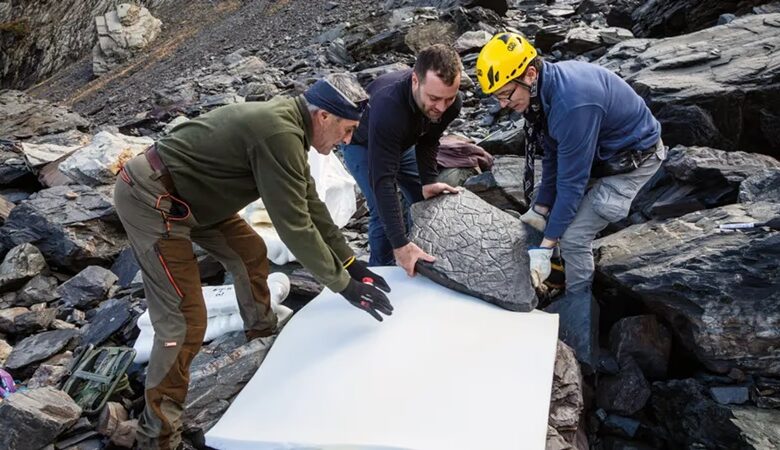280 million years old world found in Alps
News Mania Desk \ Piyal Chatterjee \ 18th january 2025

An accidental find in the Italian Alps has revealed a stunningly preserved ecosystem, 280 million years old, giving scientists a unique view into life in the Permian era.
In 2023, hiker Claudia Steffensen discovered the find while navigating the Valtellina Orobie Mountains Park, spotting strange patterns on a rock slab that looked like animal footprints. This chance observation prompted a scientific inquiry by paleontologists from the University of Pavia and the Natural History Museum of Milan.
The original rock, called “rock zero,” uncovered fossilized tracks of ancient reptiles and amphibians. Additional investigation revealed more sandstone slabs rich in fossils, featuring plant remnants, ripple patterns from prehistoric shorelines, and even impressions of raindrops.
The fossils, discovered at elevations over 9,800 feet, originate from the Permian period, a period marked by considerable environmental transformation on Earth.
In this period, significant volcanic activity caused global warming, which resulted in dry tropical conditions and extensive species extinction. Paleontologist Cristiano Dal Sasso observed that although dinosaurs had yet to develop, the animals that made these tracks were large.
Certain reptiles reached lengths of up to 10 feet, competing with contemporary Komodo dragons. The detailed fine-grained sandstone revealed complex features like claw impressions, belly scales, and fingertip marks. The remarkable preservation of the site is due to distinctive geological processes.
Seasonal variations of wet and dry phases solidified mud layers, safeguarding the imprints. Over countless years, tectonic movements linked to the creation of the Alps raised these rocks, as landslides and erosion dispersed fossil-rich pieces throughout alpine valleys.
This finding provides essential information for comprehending how life adjusts to severe environmental obstacles. It offers understanding of the resilience and susceptibility of ecosystems, possibly guiding strategies to tackle ongoing climate change effects. As glaciers recede because of global warming, additional discoveries like these may emerge, highlighting the necessity of safeguarding Earth’s. This ancient ecosystem serves not only as a scientific treasure trove but also as a reminder of our planet’s dynamic history and the valuable lessons it holds for our future.
For many individuals, endurance activities such as triathlons and marathons may appear to be impossible obstacles, meant for competitors with extensive training backgrounds. Nonetheless, for an increasing number of Indians, these intense sporting events have turned into a means to challenge personal limits, surmount challenges, and adopt a lifestyle characterized by discipline and resilience. From novice Ironman competitors to marathoners overcoming physical challenges, these new athletes have inspiring tales of determination and enthusiasm essential for succeeding in the realm of extreme sports. Here’s an overview of four people who have made pushing boundaries their lifestyle.
Diya Nayar
At the age of 41, Diya Nayar participated in her inaugural Ironman 70.3 event in Turkey this year, competing for India in the 41–44 age group. It may astonish many that she only learned to ride a bike in 2020. In 2022, she excelled in long-distance swimming. While managing a full-time job, she devoted six months to intense training for the race, waking up at 4 AM for morning workouts five to six times weekly.
The Ironman 70.3 triathlon consists of a 1.9 km swim, a 90 km bike ride, and a 21.1 km run to be completed in 8 hours and 30 minutes. Nayar’s approach incorporated nutritious home-cooked meals, emphasizing hydration and protein consumption, along with sustaining electrolyte balance while training in the height of summer.
Shanay Shah
Shanay Shah, 34, an attorney at the Bombay High Court, managed to finish three Olympic-distance triathlons and two full marathons, despite his busy schedule and challenging work hours. This year, Shah took part in Ironman Turkey 70.3 held in Antalya and also competed in Ironman Goa last October.
An asthmatic, Shah drew motivation from those who doubted his ability to take on endurance activities. “Asthma became my driving force. People said it was dangerous, but that only fueled my determination,” Shah said. His preparation included home-cooked meals supplemented by juices, salads, and protein, as well as a strict, coach-curated training schedule.
Shah’s typical week comprised two runs, two bike rides, two swims, and a strength session. “Endurance events test your mental strength. Learning to understand the science of the sport, staying patient, and replicating training sessions on race day helped me immensely,” he said. Despite challenges, such as sleep deprivation due to balancing work and training, Shanay said that staying calm and listening to his body gave him a crucial edge.
Akshay Aiyar
For Akshay Aiyar, 32, employed in the alco-bev sector, running is centered on dedication and consistency. “Aiyar stated that the most significant aspect is to show up each day.” Having taken part in significant events such as VDHM Delhi, TCSW10 Bangalore, and TMM Mumbai, he thinks that training is essential for improved performance on race day.
His training consists of a 10–16 week schedule of running four to five days a week, which includes easy runs, speed sessions, and long-distance runs. “Aiyar stated, “Meeting my protein targets is essential, although I find it challenging to manage other parts of my diet.” Due to Mumbai’s unpredictable weather, he begins his training at 6 AM and finishes by 7:30 AM to avoid the heat and congestion.
Dalip Singh Sabharwal
Bicycle Mayor Dalip Singh Sabharwal started his running journey at the age of 32 in 2017, motivated by older adults finishing the Delhi Half Marathon. Given just 40 days to prepare for the One Race Super Sikh Run Half Marathon, Dalip took a unique approach.
As a person who had never run before, trying to cover 21.1 kilometers in under a month was undoubtedly a difficult task. “I made my way to work each morning, an eight-kilometer distance, and switched between walking, jogging, and running on my return.” “Sabharwal stated that evenings were reserved for running for one to two hours.”






